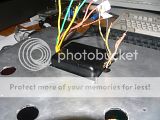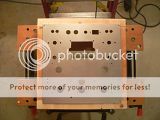I'm considering building another amp, and am wondering what the easiest way is to make a square hole for the power transformer.
The last time I used a jigsaw followed by filing the edges to fit. It wasn't hard, but took time and was fairly annoying.
Is there another method that is easier than the jigsaw and file?
Any recommendations are appreciated.
The last time I used a jigsaw followed by filing the edges to fit. It wasn't hard, but took time and was fairly annoying.
Is there another method that is easier than the jigsaw and file?
Any recommendations are appreciated.
It's one of those jobs I don't like either.
One other way is to use a nibbling tool, but that can take a while for a big transformer.
Another crude method is to drill a series of small closely spaced holes around the perimeter of the desired rectangular hole, then cut between the holes with a cold chisel, then file.
One other way is to use a nibbling tool, but that can take a while for a big transformer.
Another crude method is to drill a series of small closely spaced holes around the perimeter of the desired rectangular hole, then cut between the holes with a cold chisel, then file.
I am not sure of the material you are trying to cut, but for wood or aluminum you can use a router with a carbide burr or end mill, maybe 1/8" in diameter. Make a wood frame to guide the router to the square pattern. Make sure that the material is well attached or clamped to the frame, since the cutter may want to grab the material. Afterward, you will have 1/16" radius in the corners, which you can leave or clean up with a file.
2nd vote for frontpanelexpress.
Never again will I cut my own. My time is too valuable. A $130 perfect panel just can't be beat.
Never again will I cut my own. My time is too valuable. A $130 perfect panel just can't be beat.
I'm way too much of a tightwad to spend $130 on a panel.
A while back I had to do some duct work. Decided there had to be a better way to cut a round hole into the side of a duct in a confined space. There is! Make a square one with a dremel tool and a cutoff disc. Not hard to get nice straight lines. Don't try to go too fast or put any lateral pressure on the disc. Even the slightest lateral pressure will break the disc. This isn't a big deal provided you're wearing safety glasses. The discs come in mutlipack at your local hardware store.
A while back I had to do some duct work. Decided there had to be a better way to cut a round hole into the side of a duct in a confined space. There is! Make a square one with a dremel tool and a cutoff disc. Not hard to get nice straight lines. Don't try to go too fast or put any lateral pressure on the disc. Even the slightest lateral pressure will break the disc. This isn't a big deal provided you're wearing safety glasses. The discs come in mutlipack at your local hardware store.
Depending on the thickness of the metal you may be able to use a 'nibbler'. This is a tool that cuts rectangular holes by cutting out little rectangles of metal. It has handles like pliers that you squeeze together. Advantages- cheap ($10 US), easy to use. Disadvantages- big holes can make your hand tired!
I use them in thinner chassis for square holes for things like IEC inlets.
I use them in thinner chassis for square holes for things like IEC inlets.
CarlyBoy said:Make a square one with a dremel tool and a cutoff disc. Not hard to get nice straight lines. Don't try to go too fast or put any lateral pressure on the disc. Even the slightest lateral pressure will break the disc. This isn't a big deal provided you're wearing safety glasses. The discs come in mutlipack at your local hardware store.
I made the hole for the PT on this chassis using a Dremel with the cutoff wheels. It came out looking real nice, but took forever. The aluminum is 1/8" thick. I must have gone through at least two or three discs on each side of the hole. Definitely buy the cutoff wheels in the biggest pack they sell (25?). Go for the "heavy duty" ones, too. I wouldn't even dream of attempting this on a steel chassis.


I've been told the Gyro brand cutoff wheels are about 100 times better than the Dremel. You can find them here:
http://www.gyrostools.com
# 11-32156 and grab their mandrel model # 80-1800
benchtester said:I am not sure of the material you are trying to cut, but for wood or aluminum you can use a router with a carbide burr or end mill, maybe 1/8" in diameter. Make a wood frame to guide the router to the square pattern. Make sure that the material is well attached or clamped to the frame, since the cutter may want to grab the material. Afterward, you will have 1/16" radius in the corners, which you can leave or clean up with a file.
I'll second this one. More trouble to set up but you can use the jig forever after, and it gives pro results. I find 1/2"+ MDF is a good material to make the guide from. I like to arrange the guide above the work, and put a spacer underneath with a hole a little bigger than the guide. This way the chips fall down and don't accumulate in the work. If the chips are allowed to build up the cutter will jam, overheat, and drift.
Then I clamp all 3 in exact position down to the work table and use a good carbide router bit (I like 1/4") Cut with the ball bearing running along the inside of the guide above the cutter. Run the router at low speed depending on the metal. A little trial and error is needed for the speed setting. It goes fast enough that you can take your time cutting.
This method also works for arbitrary shapes like curves and slots, and can cut brass, copper, aluminum, wood, and plastic like gray PVC sheet (lexan and plexiglass are tricky because they like to melt). It's effective for the IEC outlet opening.
So if you go this route as opposed to a machine shop or frontpanels.com you will need a nice variable speed plunge router ;-) ;-) You can also use the router to cut the guide for best results.
I also second the machine shop recommendation but it can be satisfying to do it yourself...
Cheers
Michael
I make transformer cut-outs in steel chassis and aluminum..
I use the Dremel tool with the cutting wheel..with good sucess..
Get the thin cutting wheel...not the thick one.. The thin one cuts better and quicker...also cleaner cut...
**** PLEASE USE SAFETY GLASSSES WHEN DOING THIS****
When the cutting wheel snaps, which happens often...a piece can go into your eye....
Chris
I use the Dremel tool with the cutting wheel..with good sucess..
Get the thin cutting wheel...not the thick one.. The thin one cuts better and quicker...also cleaner cut...
**** PLEASE USE SAFETY GLASSSES WHEN DOING THIS****
When the cutting wheel snaps, which happens often...a piece can go into your eye....
Chris
Based on everyone's suggestions, I picked up a Dremel cutting wheel and a tungsten bit, and have made a jig. I have a roto-zip.
I'll have to see which works best - the bit or wheel (or a combination of both).
The bit will also be used to cut speaker holes.
I'll have to see which works best - the bit or wheel (or a combination of both).
The bit will also be used to cut speaker holes.
PRNDL said:Based on everyone's suggestions, I picked up a Dremel cutting wheel and a tungsten bit, and have made a jig. I have a roto-zip.
I'll have to see which works best - the bit or wheel (or a combination of both).
The bit will also be used to cut speaker holes.
**** PLEASE MAKE SURE TO USE SAFETY GLASSSES WHEN DOING THIS****
I have seen very bad things happen when I was working in machine shops as a teenager.... I also seen very bad stuff when I worked in Emergency Rooms as a paramedic....
Best Regards
Chris
I hope any of you are still around 🙂 I have tried to find a carbide router for my dremel, but can't find any with ball bearing, or a copy ring.
I have a carbide router, and it cuts fine in aluminium sheet, but how do I make the square hole with making a very big guide.
I have this https://www.dremel.com/en-us/Attachments/Pages/ProductDetail.aspx?pid=566
But it seems a bit much, to make a big guide, where this fits inside. My big Bosch router comes with a copy ring, and that would be a bit easier. But, the best would be to be able to use a guide of the same size as the IEC hole
I have a carbide router, and it cuts fine in aluminium sheet, but how do I make the square hole with making a very big guide.
I have this https://www.dremel.com/en-us/Attachments/Pages/ProductDetail.aspx?pid=566
But it seems a bit much, to make a big guide, where this fits inside. My big Bosch router comes with a copy ring, and that would be a bit easier. But, the best would be to be able to use a guide of the same size as the IEC hole
I know it will take 2 minutes to cut a perfect hole. I just need either the right router or a copy ring - i might just make one myself.
- Status
- Not open for further replies.
- Home
- Design & Build
- Construction Tips
- easier way to cut a square hole for xmfr